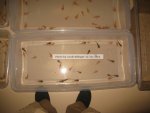Jake
Well-known member
- Joined
- Nov 1, 2006
- Messages
- 1,635
- Reaction score
- 87
- Points
- 48
- Location
- Illinois, US
- Country
- United States
- Display Name
- Jacob Bidinger
I've notice a lot of people in the past have struggled to keep axolotls. This is a helpful thread on how to keep them healthy using my advanced system. To go through with this you must have the following long list of high tech equipment:
1. A tub (or tank for ease of viewing if you can't see your axolotl when you look down at it in a shallow tub of water)
2. Cool, clean water
3. A good food source. I personally use earth worms but you can use others, they're usually not picky.
4. A bowl or another tub of the same size
5. Common sense. Most people struggle with this one so please be careful.
Step 1: Place at least enough water in the tub to cover the axolotl, more is OK if desired.
Step 2: Add the axolotl to the water
Step 3: Once every day (or twice if they're very young) add some food, you'll eventually know how much they will eat after watching them
Step 4: When the axolotl produces waste place them in the bowl or separate tub with water and dump the old water and scrub the fine layer of slime that has formed (if it has formed) in the tub.
Step 5: Replace the water in the original tub
Repeat steps 1-5 as needed.
Step 6: This is just as important as steps 1-5 so pay close attention: Leave the axolotls alone! Disturbing them frequently is stressful to them. Many people on this very site are guilty of literally loving their axolotls to death. If you want a pet you can handle get a rat.
Below I've included some photos to help. Please brace yourself and make sure you are seated when you view the photos because they just might blow your mind!!
The first image is of my extremely advanced enclosures for young juveniles. Pic#2 is one of my high tech adult axolotl enclosures, a 5.5 gallon tank half filled with a 9 inch male living in it. Pic #3 is a special treat for those who can't see the axolotls in the tubs. It is a glass 2.5 gallon aquarium half filled. Pic 4 is an example of the complex system I have set up for growing out juveniles, they are shoe box sized Sterlite tubs with ~3 inches of water housing 6 inch long juveniles. Pic #5 is just to show the similarity in size between the complicated axolotl habitats in pics #3 and #4.
1. A tub (or tank for ease of viewing if you can't see your axolotl when you look down at it in a shallow tub of water)
2. Cool, clean water
3. A good food source. I personally use earth worms but you can use others, they're usually not picky.
4. A bowl or another tub of the same size
5. Common sense. Most people struggle with this one so please be careful.
Step 1: Place at least enough water in the tub to cover the axolotl, more is OK if desired.
Step 2: Add the axolotl to the water
Step 3: Once every day (or twice if they're very young) add some food, you'll eventually know how much they will eat after watching them
Step 4: When the axolotl produces waste place them in the bowl or separate tub with water and dump the old water and scrub the fine layer of slime that has formed (if it has formed) in the tub.
Step 5: Replace the water in the original tub
Repeat steps 1-5 as needed.
Step 6: This is just as important as steps 1-5 so pay close attention: Leave the axolotls alone! Disturbing them frequently is stressful to them. Many people on this very site are guilty of literally loving their axolotls to death. If you want a pet you can handle get a rat.
Below I've included some photos to help. Please brace yourself and make sure you are seated when you view the photos because they just might blow your mind!!
The first image is of my extremely advanced enclosures for young juveniles. Pic#2 is one of my high tech adult axolotl enclosures, a 5.5 gallon tank half filled with a 9 inch male living in it. Pic #3 is a special treat for those who can't see the axolotls in the tubs. It is a glass 2.5 gallon aquarium half filled. Pic 4 is an example of the complex system I have set up for growing out juveniles, they are shoe box sized Sterlite tubs with ~3 inches of water housing 6 inch long juveniles. Pic #5 is just to show the similarity in size between the complicated axolotl habitats in pics #3 and #4.
Attachments
Last edited:





